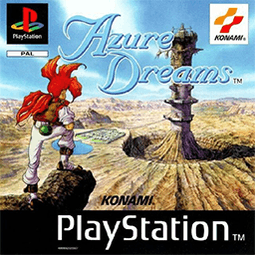Azure Dreams
| Azure Dreams | |
|---|---|
 | |
| Developer(s) | Konami |
| Publisher(s) | Konami |
| Composer(s) | Hiroshi Tamawari |
| Platform(s) | PlayStation, Game Boy Color |
| Release date(s) |
PlayStation Game Boy Color |
| Genre(s) | Roguelike, role-playing video game |
| Mode(s) | Single-player |
Azure Dreams, released in Japan as Other Life: Azure Dreams (アザーライフ アザードリームス Azā Raifu Azā Dorīmusu), is a PlayStation video game developed by Konami and was originally released in Japan on November 13, 1997. A stripped down version was later released on the Game Boy Color. A semi-sequel, Tao's Adventure: Curse of the Demon Seal, was released on the Nintendo DS in 2005.
Story
Azure Dreams is set in the desert town of Monsbaiya. The town prospers because of a Monster Tower located over it. A skilled monster tamer named Guy disappears in the tower and is never seen again. Ever since he disappeared, his son enters the tower when he turns 15 and meets a familiar named Kewne, a monster that can speak to humans. Kewne and Koh embark on a quest to reach the top of the Monster Tower and find the truth about Guy's fate.
Gameplay
The game offers a lot of choice in respect to how individual players wish to play. The main focus of the game is entering the tower and destroying its denizens, collecting treasure and monster eggs to hatch into familiars. Each monster has hidden spells, unique traits, and abilities. But an interesting side mission is the improvement of the town of Monsbaiya. With his acquired riches, Koh can finance the building of a theatre, hospital, racing track, casino, bowling alley, and gym. Some buildings allow the appearance of specific love interests (such as the Hospital making way for Cherrl to appear and the library making Mia available), while others offer mini-games and the ability to acquire currency at a faster rate. Koh can also improve the furnishings and decorate his home.
The player is also given the option of pursuing romantic ambitions in Koh's life. There are seven characters that he may develop a relationship with, from tomboy Nico to stuck-up, selfish Selfi. There are a few differences that exist between the Japanese and American versions of the game, in the Japanese version it had voiced dialogue for every character, the title screen was dramatically changed, the intro movie was narrated and the angel/cherub was more animated, larger and looked much different. The monster book graphics were also redone. The Japanese version has a seahorse like selector with more colorful elemental bars, for example the water one has vines growing on it. The layout of the picture and text was different also with the Japanese version having the monster text off to the right and the stats under the picture. The buttons were also completely changed from the Japanese version, and not just an O, X swap. This relationship-building aspect of the game is absent from the Game Boy Color version.
Every time Koh enters the Tower, he returns to level one; however, any familiars hatched outside the Tower retain their current level. As such, progression through the higher levels of the Tower relies on strengthening the familiars or equipment. Strengthening weapons and shields can be an uphill battle, because the items that add a +1 to their attack or defense are often far outnumbered by Rust Traps, one of the many varieties of randomly generated traps that only become visible once activated. One remedy to this is to use types of equipment that do not rust. Furthermore, once in the Tower, there are only three ways of exiting it: If Koh "dies" within the Tower, he returns to town but loses all equipment he carried; a familiar can be sacrificed using a specific item found within the Tower, called an Oleem, allowing Koh to escape and keep all of his other equipment; and a Wind Crystal can be found in the Tower that allows escape at any time.
Another unique point of Azure Dreams is the random map generator: every time Koh enters the Monster Tower, the levels are randomly generated so as to make every monster-hunting experience different.
In many ways, Azure Dreams is a graphical roguelike. Activity within the main dungeon is turn-based, with one move or attack corresponding to a turn (e.g. when the player takes a step, so do opposing monsters). Randomly generated dungeons and treasures are also features shared with the genre.
Soundtrack
The game's soundtrack is composed by Hiroshi Tamawari.
Reception
| Reception | |||||||||||||||||||||||||||||||||||
|---|---|---|---|---|---|---|---|---|---|---|---|---|---|---|---|---|---|---|---|---|---|---|---|---|---|---|---|---|---|---|---|---|---|---|---|
| |||||||||||||||||||||||||||||||||||
The game received "average" reviews on both platforms according to the review aggregation website GameRankings.[10][9]
References
- ↑ House, Michael L. "Azure Dreams (PS) - Review". AllGame. Archived from the original on November 14, 2014. Retrieved June 13, 2016.
- ↑ "Azure Dreams (PS)". Electronic Gaming Monthly. 1998.
- ↑ "Azure Dreams - PlayStation". Game Informer (73). July 1998. Archived from the original on September 21, 1999. Retrieved June 13, 2016.
- ↑ Air Hendrix (1998). "Azure Dreams for PlayStation on GamePro.com". GamePro. Archived from the original on February 7, 2005. Retrieved June 13, 2016.
- ↑ Mielke, James (July 22, 1998). "Azure Dreams Review (PS)". GameSpot. Retrieved June 13, 2016.
- ↑ Cleveland, Adam (February 24, 2000). "Azure Dreams (GBC)". IGN. Retrieved June 13, 2016.
- ↑ Frost, Steven (August 24, 1998). "Azure Dreams (PS)". IGN. Retrieved June 13, 2016.
- ↑ "Azure Dreams". Official U.S. PlayStation Magazine. 1998.
- 1 2 "Azure Dreams for Game Boy Color". GameRankings. Retrieved June 13, 2016.
- 1 2 "Azure Dreams for PlayStation". GameRankings. Retrieved June 13, 2016.